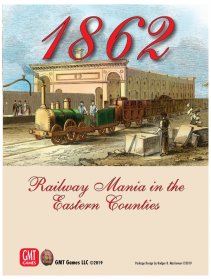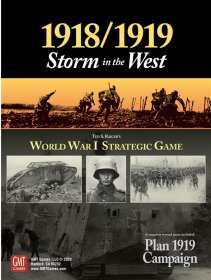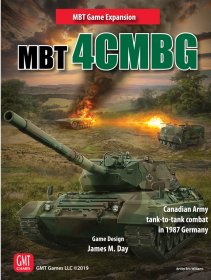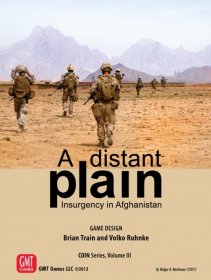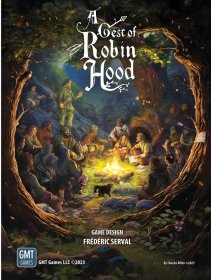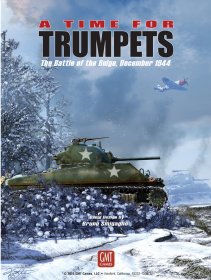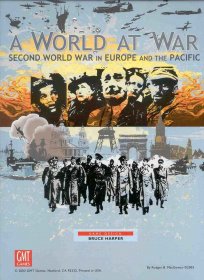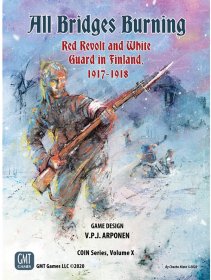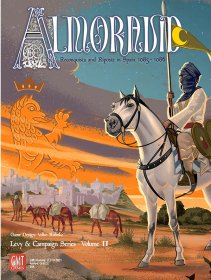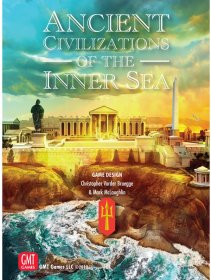- 24 Hour Marathon Raffle
- Advanced Squad Leader
- American Civil War
- American Revolutionary War
- Ancient Battles
- Books/Magazines
- Card Games
- Family
- Fantasy
- Gaming Accessories
- Horror
- Miniatures
- Napoleonic Battles
- Other
- Other Wargames
- Post WW2
- Pre-Napoleonic
- Role-Playing
- Sci-Fi
- Solitaire
- World War 1
- World War 2
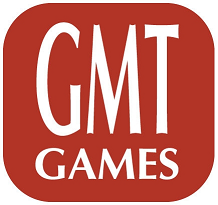
Sort by:
Name A - Z
-
1846: The Race to the Midwest
In 1846, 3-5 tycoons compete to earn money and build the best stock portfolio by investing in and operating railroads within the midwestern United States. Five competing railroads, in search of Midwestern grain and markets, crossed the Appalachian mountains in the early 1850s: the New York Central, Erie, Pennsylvania, Baltimore & Ohio, and, via Canada, the Grand Trunk, backed by Boston merchants.In front of them were literally hundreds of failed local railroads, most existing only on paper, but a few had laid bits of track and acquired locomotives, before running out of capital and being sold to Eastern interests in 1846.
Can you knit together these private companies and Eastern railroads to form the most profitable rail network in the Midwest, stretching to Chicago and St. Louis and connecting East and West? -
1862: Railway Mania in the Eastern Counties
The year is 1843, and Great Britain is poised to see the country gripped by a new disease - Railway Mania. Rail transportation to link industrial Great Britain together has captured the public imagination, and thanks to a rapidly expanding affluent middle class, more than enough money is available to build that rail net. Scores of new railway companies spring up. With virtually no governmental oversight, many fraudulent or economically unfeasible railways appear, financed by a tidal wave of cash from starry-eyed investors. By 1849 the spectacular railway construction bubble completely bursts, thousands of individual investors are ruined, and the surviving well-run rail lines move into the financial wreckage to salvage the workable lines, continue construction through the next decade, and grow stronger.
1862: Railway Mania in the Eastern Counties is set in this cauldron of railway construction. Players will vie to start railway companies, invest money in railway shares, and attempt to run the railways they control for personal gain, trying to keep them afloat in changeable economic times. Each game played will be unique. Out of 20 available railway companies, only 16 will be randomly selected for each game – and only eight will be available at start. Each company also starts with a randomly chosen Permit to run one of three different types of train. Players then begin the game by investing in some of the available companies. Each company will generate revenue for the majority shareholder by laying track on the board, placing station markers, running any trains it owns, paying dividends or retaining revenue from those trains, and then buying more and more advanced trains. As the game progresses, players can start more companies and can merge companies they control with other companies. When larger and more powerful trains are bought, older trains become obsolete and disappear, causing financial crisis for the unprepared. The game ends after the last band of trains is bought, and the wealthiest player, including shares, but not money in companies, is the winner.
-
1918/1919: Storm in the West
In 1992, Ted S. Raicer published his first design in the late lamented Command Magazine, 1918: Storm in the West, covering the last nine months of WWI on the Western Front. The game was an immediate success, earning a Charles S. Roberts Award nomination, and leading to the design of a Plan 1919 variant which assumed a German defensive strategy in 1918 and an all-out Allied assault to win the war the following year. GMT is pleased to offer a new boxed version of these classic Great War designs, with new artwork, and including an additional 1918 Allied Offensive scenario published later in Command.
This new GMT boxed version of 1918/19: Storm in the West is a two-player system that also works fine for solo play. Units are mostly corps (divisions for the USA, whose oversized units were nearly the size of Allied corps), and include infantry, tanks, cavalry and air support. The Germans start the 1918 campaign with large numbers of Stosstruppen, trained to overcome the trench stalemate of the previous three years. This gives the German player a strong offensive capability in the first half of the game. But these “shock troops” are a wasting asset, and if the Allies survive the initial blows, growing numbers of US troops and Allied tanks will see the Germans forced into a desperate defense in the game's second half.
In the Plan 1919 campaign, the Germans are assumed to have used the collapse of Russia to stabilize the Balkan and Italian fronts, forgoing the historical 1918 Kaiser's Battles in the West. The Allies are thus faced with a strong German defense, but with a fully mobilized American army and backed by masses of tanks and planes. This hypothetical campaign challenges the Allies to leverage these arms into the world's first blitzkrieg, while the Germans fight to force a stalemate that will leave them dominant in Europe.
The large-hex map, scaled at 8 miles to the hex, covers the active area of the Western Front, from Epinal in the south to Antwerp and the Channel Coast in the north. Terrain includes Forts, Allied trenches, German Secondary and Primary Trenches, Forts, Forest, Marsh, Flood Plain, Mountain, and the Devastated Zone created by the German withdrawal in the Somme sector in 1917. The map is back-printed with separate versions for the 1918 and 1919 Campaigns.
Simple but not simplistic, this new GMT version of 1918/19: Storm in the West can be played in a single session and offers players a wide range of strategic and operational choices in bloody but dynamic campaigns to decide the outcome of the First World War. With updated artwork by Mark Simonitch and Charlie Kibler, this new combined edition is a must for lovers of classic wargaming.
-
1989: Dawn of Freedom 2nd Edition
1989 is an exciting, fast paced game simulating the end of the Cold War in 1989. During this amazing year, a series of democratic revolutions ended the 40 year Soviet empire in Eastern Europe. 1989 simulates the political, social and economic aspects of these revolutions using a card driven system similar to Twilight Struggle.
One player plays the Communist. At the start of the game he holds unquestioned power across the six nations of the Warsaw Pact. But there are omnious clouds on the horizon. The new leader in Moscow has declared no more will Soviet tanks prop up tottering Communist governments. The economies, after decades of central planning and stagnation, have reached various stages of crisis. Inside the churches and among the students and their professors there are dissident movements that have been emboldened. From crushing dissent to offering concessions, the Communist player will have to use a variety of strategies in a struggle to hold on to his empire.
The other player plays the Democrat. At the dawn of 1989, behind the iron curtain, no one considers revolution possible. The goal of dissidents is to create a civil society outside the control of the Communist regimes. On their side are students who are fascinated with the style and pop culture of the west, and the Church. Against them is the vast apparatus of the Communist state. Their challenge is to persuade the workers, who are the bulk of society, to join their cause.
-
4CMBG: MBT Expansion #3
The 4th Canadian Mechanized Brigade Group (4CMBG) is the forward element of Canadian Forces Europe. Positioned at Lahr in Southern West Germany, the brigade is poised to support VII (US) Corps and II (FRG) Corps against incursions from Soviet GSFG or CGF forces.
This MBT expansion focuses on Canada’s armored and mechanized forces. Battle it out in new scenarios and combine the 2 new double-sided geomorphic maps with the MBT base game maps and the BAOR and FRG Expansions for exciting battles.
Includes detailed TO&E for the Canadian Brigade.
IMPORTANT NOTE: In order to play this expansion, the MBT basic game is required; the BAOR and FRG Expansions are not.
COMPONENTS
- 1 8½” x 11” Counter Sheet
- 2 double-sided geomorphic Map Panels
- 5 double-sided full-color 5” x 4” Data Cards
- 24 page Full color 8½” x 11” Playbook
-
A Distant Plain
Afghanistan—scene of tribal, ethnic, colonial, and Cold War conflict across the ages. Into this cockpit dropped a multinational post-9/11 coalition to root out al-Qaeda and replace the hardline-Islamist Taliban regime that harbored it. A quick invasion and regime change portended quiet reconstruction and good governance, but it was not to be so. In their sanctuary across Pakistan's border, the Taliban rebuilt for an insurgency that would ensnare the Coalition in the tangle of Afghan rivalries, shifting allegiances, and warlordism that the West could at first only distantly grasp.
The latest volume in Volko Ruhnke's COIN Series takes 1 to 4 players into the Afghan conflict of today’s headlines, this time in a unique collaboration between two top designers of boardgames on modern irregular warfare. A Distant Plain teams Volko Ruhnke, the award-winning designer of LABYRINTH—The War on Terror, with Brian Train, a designer with 20 years' experience creating influential simulations such as Algeria, Somalia Interventions, Shining Path, and many others.
A Distant Plain features the same accessible game system as GMT's recent Andean Abyss but with new factions, capabilities, events, and objectives. For the first time in the Series, two counterinsurgent (COIN) factions must reconcile competing visions for Afghanistan in order to coordinate a campaign against a dangerous twin insurgency.
As the Coalition, how will you secure popular support for an Afghan Government that cares more about corrupt patronage and control than legitimacy? Your high-tech forces are capable, but your publics are pressuring you to keep your footprint small: how will you stabilize this complex country and get out?
As the Government, how can you run the country when your foreign partners continually redirect your war effort? You can reshape Afghanistan's human terrain by encouraging the resettlement of millions of refugees, and your Coalition-trained forces are potentially the most numerous of any faction. But they are unsteady, and your war chest is not your own: how will you keep your allies' firepower in-country long enough to ensure that you are the top dog once they leave?
As the Taliban, how will you come back against the potent forces arrayed against you? Islamism, Pashtun ethnic solidarity, and your Pakistani friends behind you will help you recruit and move with ease amidst the enemy. But not all Afghanistan is Pashtun, its warlords are treacherous allies at best, your fighters are seasonal, and Pakistan’s word is ever uncertain: can you sting the occupier and his puppets to reawaken Islamic revolution without drawing an unrelenting fire upon yourself?
As the Warlords, how will you secure your traditional ways against the intrusive centralizers of Kabul and the Taliban? You profit from the country's lucrative opium crop, and your money can talk loudly to the Government's venal officials. But your fighters have neither the equipment of the Coalition, the numbers of the national army and police, nor the fanaticism of the Taliban: how will you block this latest cast of combatants from unifying the country and imposing their rule on you?
A Distant Plain adapts familiar Andean Abyss mechanics to the conditions of Afghanistan without adding rules complexity. As with each COIN Series volume, players of A Distant Plain will face difficult strategic decisions with each card. The innovative game system smoothly integrates political, cultural, and economic affairs with military and other violent and non-violent operations and capabilities. Terror, drug trafficking and eradication, highway extortion and sabotage, drone strikes, and many more options are on the menu. Flow charts are at hand to run the three Afghan factions, so that any number of players—from 4 to solitaire—can experience the internecine brawl that is today's Afghanistan. Have a good tour.
-
A Gest of Robin Hood
Expected on Jun 15, 2024A Gest of Robin Hood is the second game in the Irregular Conflicts Series, further adapting the COIN system to depict peasant revolts, feudal tax collection, and outlaw activities in late 12th century medieval England. Transposing one of GMT’s most popular systems into a simpler format and a more approachable setting makes A Gest of Robin Hood perfect for newcomers to wargaming. At the same time, it also offers a tight challenge for more experienced wargamers who can enjoy a tense asymmetric duel in under an hour.
Highlights:
- An ideal entry point to the COIN system and the ICS series: a two player, relatively low complexity game with a family friendly theme that plays in one hour and introduces all of the key concepts found in the COIN series.
- A new hidden movement mechanic: The Sheriff will chase Robin Hood across Nottinghamshire to prevent him from organizing peasant revolts, but Robin can sneak away and hide amongst his Merry Men.
- A second new hidden movement mechanic: Carriages serve as a simple twist on Lines of Communication, transferring wealth back to Nottingham while providing a target for robbery by the Merry Men—but some of them might be a trap, containing concealed Henchmen!
- Random encounters with rich travelers: Robin Hood draws from the Travelers Deck when conducting a Rob action, then decides whether to play it safe or demand a larger ‘donation’ with potentially negative consequences.
- A streamlined sequence of play: Further developing the two-player sequence of play first found in Colonial Twilight, this new sequence of play is easy to understand while still presenting difficult tactical decisions
- Robin Hood and the Merry Men: Robbing from the rich to give to the poor. An archetypal insurgency faction focused on undermining the Sheriff’s authority by inciting peasant revolts, robbing carriages and travelers, and building a network of camps across Nottinghamshire.
Player Factions:
The Sheriff of Nottingham and his Henchmen: In charge of maintaining order and collecting taxes for Prince John. A proto-counterinsurgent faction focusing on suppressing peasant revolts and securing roads to ensure the safe travel of wealth confiscated from the parishes.
Historiography of Robin Hood:
The year is 1192. Richard I “Lionheart” is held captive by Duke Leopold of Austria, interrupting his return from the Crusades. Meanwhile, the King’s brother Prince John rules England as his regent. Prince John uses his temporary powers to increase taxes and pass laws in favor of loyal members of the nobility and clergy. Sir Robin of Locksley, a young and courageous minor noble, has recently returned from the Third Crusade to see his family dispossessed of its wealth by the corrupt Sheriff of Nottingham. He decides to revolt against what he perceives as an illegitimate authority and takes to the forest where he finds unlikely allies: rogue yeomen, poachers, and other bandits. Perhaps this sounds familiar?
This version of the story of Robin Hood, the one many of us grew up with, is surprisingly modern and polished, as it is based on 19th century retellings of older folktales by authors such as Howard Pyle. Additional layers have later been added to the character of Robin Hood by the 20th century film industry, from the 1922 adventure film starring Douglas Fairbanks, right through to the gritty reboots of the past decade. The original version of Robin Hood can be traced back to the 14th Century, first appearing in a brief mention in the allegorical poem Piers Plowman (~1370s) and then later reappearing in a variety of ballads. His first dedicated literary work (that we know of) is A Gest of Robyn Hode, printed around the turn of the 15th and 16th centuries, which compiles several older tales of a heroic outlaw fighting for justice. This original version of the Robin Hood character was slightly different from the one that we know today: rougher, more violent, and closer perhaps to the contemporary image of a guerrilla fighter.
In 1958, the medieval historian Rodney Hilton published a study of the original Robin Hood tales and what they symbolized. The audience for these tales were the common people of the late 14th century, and we can see that the character is himself kind and well-tempered when dealing with representatives of these people, such as the Potter, but behaves ruthlessly with representatives of the ruling class, like the pompous Bishop of Hereford. Members of the emerging free peasant class recognized their struggles in the heroic figure of a brave yeomen, fighting unfair taxes and judiciary systems established to keep them in check. In this narrative, the King is a distant and kind figure unaware of the people's suffering, who will eventually support them in their struggle once he returns to restore justice. This illusion would fade after the 1381 peasant revolts and Richard II’s betrayal of the common folk.
A Gest of Robin Hood taps into this rich historiography, leveraging the romantic story that we all know but setting it in a more realistic context by depicting Robin Hood as a complex figure. A social bandit, as the historian Hobsbawm describes him, at the head of an insurrection against the Sheriff of Nottingham.
Game components- 17” x 22” mounted game board
- Event Deck
- Travellers Deck
- 37 Wooden Pieces
- 5 Pawns
- One half-size, full-color countersheet
- Two player mats
- Two player foldout screens
- Two custom 6-sided dice
- Rules of Play booklet
- Playbook booklet
- Learn to Play booklet
- A 2" box
Number of players: 2
-
A Time for Trumpets
A Time for Trumpets (ATFT) is a battalion level game of the Battle of the Bulge. The game system incorporates a number of concepts from two the highly playable games on the same subject: Bitter Woods by The Avalon Hill Game Company and the iconic battalion level Wacht am Rhein from SPI in 1977. In addition, the command and control concepts devised for the TAHGC version of The Siege of Jerusalem were utilized.
Most of the ground combat units in “ATFT” are battalion sized combat units. The battalion is homogeneous with regard to mission and functionality. Homogeneous, because an infantry battalion is comprised primarily of infantry companies, a tank battalion is comprised primarily of tank companies, etc. A battalion based game is designed with differentiation inherent to the system, whereas a regimental level game is designed with integration inherent to the system. For example, in a battalion level game, Kampfgruppe Peiper will include at least two separate panzer battalions, a panzer grenadier battalion, an AA battalion and an artillery battalion; whereas in a regimental level game, KGP will be comprised of one counter representing all of the aforementioned units.
The Divisional compositions include HQ, the front line battalions and the combat support battalions: recon, engineers, anti-tank, anti-aircraft and artillery. The individual field battalions perform game functions that attempt to simulate the battlefield actions of their real-life models. The aircraft squadrons include those that were most numerous over the battlefield in December 1944: P47, B26, ME109, JU88 and ME262.
Front line battalions are the primary forces that try to wrest territory from the enemy, while also being assigned to prevent the enemy from doing likewise. Armored recon units function as cavalry, which is a difficult proposition given the weapons employed. Engineers perform the specialized missions that can only be approximated in higher level. In addition to lending their expertise to direct combat in a combined arms fashion, they construct strong defensive positions and bridges, and of course, they blow things up. Anti-tank units provide a strong backbone to defensive positions while still possessing a moderate offensive potential. Light anti-aircraft provides defense against aircraft while effectively creating problems for enemy infantry not supported by tanks. Heavy anti-aircraft provides enhanced defense against aircraft while stiffening resistance against enemy tanks. Last, but not least, conventional field artillery (FA) and massed German rocket artillery (NW) rules the battlefield when they are able to achieve local superiority.
In order to maintain the combat Divisions and Brigades as cohesive and compact entities, the successful command and control concepts similar to those of Wacht Am Rhein 1977 have been utilized. Division/Brigade combats units must be in Command Range of their HQ, while their HQ must be in Command Range of their Corps HQ, etc. Much effort has been expended to make this system easy to play. Every formation has been color-coded, so that visual segregation and recognition are immediately obvious.
The game map is at the scale of one hex equals a mile and was developed using the 1-50,000 1943-1944 GSGS 4040 and GSGS 4507 topographical maps. Players will easily recognize the influence of the Bitter Woods game map as terrain is easily recognized and differentiated.
Game concepts include: HQ activation status (active or resting), fatigue and exhaustion, command and control, formation supply, supply by air, German fuel shortages, American supply dumps, ground conditions, atmospheric conditions, air strafing and interdiction, construction of defensive positions and bridges, demolition, sacrosanct formation boundaries, limited winter movement across rivers and streams, strategic movement, infiltration due to limited visibility, over-run of vulnerable units, German night combat advantage, Kampfgruppe Peiper Breakout, German Nebelwerfer Operations, German FA Operations, Allied FA Operations, Time on Target, terrain effects for ground combat, weapons effects on ground combat, exploitation after combat, etc.
Extensive research using the most modern sources available has assured an accurate and complete Order of Battle. Also included are optional random events that will provide additional challenges for those inclined. Scenarios will include the Campaign Game, 6th Panzer Army, 5th Panzer Army, 7th Army, Patton's Relief of Bastogne, and the Race to the Meuse.
Components:
- 5 full size maps
- 12 counter sheets
- 1 rules booklet
- 1 Scenario booklet
- At least 6 player aid cards
- 2 dice
Time Scale: 4 turns per day
Map Scale: 1 mile per hex
Ground Unit Scale: Battalion
Air Unit Scale: 25 aircraft per counter
Number of Players: 2 to 5
-
A World At War (WWII)
A World At War completes the Advanced Third Reich/Empire of the Rising Sun game system, refining and clarifying the rules in every area of the game. Five years of design and relentless playtesting have resulted in a polished and proven game. A World At War includes a dozen campaigns or scenarios, ranging from the introductory Battle of the Atlantic and Barbarossa scenarios up to separate European and Pacific Campaign Games. Dedicated gamers will be hard-pressed to resist the testing their luck and skill by taking on the biggest campaign game: the entire war in Europe and the Pacific. Scenarios include Campaign game covering: Global War, European Theater, Pacific Theater, Global War (historical), European Theater (historical), Pacific Theater (historical), plus, Battle of the Atlantic, Barbarossa, North Africa, Coral Sea, Midway, and Leyte Gulf. -
All Bridges Burning: Red Revolt and White Guard in Finland, 1917-18
The year is 1917. Russia’s Tsar Nicholas II has abdicated and Russia slides toward an ever deepening internal crisis. On the western edge of the vast Russian Empire, the uncertainty in Russia is giving rise to a power vacuum in the semi-autonomous Grand Duchy of Finland. For many across the Finnish political spectrum, the turmoil in Russia looks like an opportunity to fulfill the dream of Finnish national independence. Yet the competing factions are unable to agree on a common political vision for the country. By January 1918, a bloody civil war will have broken out in Finland.

All Bridges Burning recreates the political and military affairs of the Finnish civil war in a new COIN System volume for three players. The Reds seek to stage a working class revolt and then hold on to their gains, while the White Senate forces seek to reassert control. A third, non-violent Moderates faction fights for the survival of parliamentary democracy and political reform. All three factions must keep the national sentiment conciliatory enough for a post-conflict settlement and national independence. In addition, the non-player powers of Germany and Russia offer military assistance to the Senate and the Reds, respectively. Excessive foreign involvement, however, could quash the dream of Finnish independence and prompt a collective loss of all three player factions. Historical events, asymmetrical action menus, as well as extensive historical design notes familiarize the players with the historical period.

A unique sequence of play for three factions poses players – whether veteran or new to the COIN Series – fresh challenges in selecting from the asymmetric commands and special activities. The Reds will find themselves needing to split time and resources between competing tasks of solidifying the Red revolt by creating working organs of civilian administration on the one hand, and fighting an increasingly desperate war against a far more powerful enemy on the other. The White Senate faction, in contrast, has a more traditional war to fight. The Senate will want to enhance their military performance by capabilities such as armored trains, cannons, as well as the Finnish, German-trained 27th Jaeger Battalion. Meanwhile the Moderates will be focused on building and maintaining underground networks of information, distributing news across the fronts, and advancing a stagnating political process while fending off retributions from the two warring factions.
A simple but effective cards-based non-player system enables the game to be played solitaire as well as in a two-player mode. The structure of the sequence of play, the character of the commands and special activities in the game, the smaller number of players, and compact size combine to enable All Bridges Burning to play fast. The solitaire system has been designed to preserve that speed and fluidity of play.

-
Almoravid: Reconquista and Riposte in Spain, 1085-1086
Al-Andalus, 1085. The western jewel of Islam had broken into pieces. The petty Taifa emirs who inherited the once-mighty Caliphate squabbled and fought, then paid the Christian lords Parias in gold to avoid fighting at all. Alfonso VI, Christian king of a unified León and Castilla, could now put his extorted dinars to work. He would muster a great feudal host—not merely for plunder but to rip out the heart of Muslim Spain. He would seize the ancient Visigothic capital of Toledo and with it the great central plain to declare himself imperator of all Iberia.
But Alfonso would find there was fight left in al-Andalus, as Christian strikes radiating from Toledo were too much for even the emirs in their pleasure palaces to bear. Al‑Mutamid of Sevilla, the strongest among them, would risk the Taifa dynasties’ independence and call to arms a Muslim force unlike any that the Christian Kings had faced. Granada and Badajoz would join him to invite the Almoravid fundamentalists in to save the Muslim faithful. Yusuf, Sultan al‑Murabitun, had secured his Berber empire in Africa and seized a port and fleet just across the Mediterranean strait from al-Mutamid's Algeciras. A titanic campaign for Spain was set to unfold.
Almoravid, Volume II in Volko Ruhnke's Levy & Campaign Series, takes us from Nevsky's frozen northeast frontier to medieval Latindom's opposite corner. The same base rules show the muster of lords, their levy of forces and capabilities, and their command of armies on campaign across 11th-Century Spain. But al-Andalus was not Russia: your lords will enjoy good Roman roads and gentler seasons but must bypass or smash against Iberia’s profusion of tough Moorish fortifications. Taifa politics and Parias tribute will guide your military strategy. African troops, bloodthirsty crusaders, the avaricious Cid—each may or may not make their appearance. And all will play out across a field half again as large as that of the first volume.
-
Ancient Civilizations of the Inner Sea
Ancient Civilizations of the Inner Sea is an exciting, easy-to-learn, easy-to-play but challenging to master abstract game in which players guide the renowned and legendary civilizations that surged and receded around the shores of the Mediterranean, which the Romans aptly called the Mare Internum, or Inner Sea.
Ancient Civilizations of the Inner Sea is not just one game but many games. From one to six players will take the role of one, two, or even three of these civilizations as they compete across up to four epochs on land and sea, seeking to survive a host of potential natural disasters while making their indelible mark on history through conquest and the building of cities and great Wonders: thereby becoming the dominant power of their age.
Extensive Solitaire Rules allow any scenario, including the basic game, to be played by a single player against one or more Non-Player Civilizations (NPCs). The NPC component may be peaceful or hostile, or change their attitude depending on the actions of the player. Historical War Game Scenarios offer particularly aggressive Solitaire system-controlled opponents for those who want to fight to expand or defend their civilization.
If you want a War Game, let it begin here -- but if you want a friendly game, this is it!
Ancient Civilizations of the Inner Sea can be all about war - but it does not have to be. It can be a friendly game of exploration, city building, trade, and the construction of up to seven Wonders such as The Great Pyramid. Any player or players, solitaire or in a group of up to six, can make of Ancient Civilizations what they wish or imagine. Competition can be martial or cultural, warlike or friendly, or a combination of both - how the game plays depends entirely on how the player or players want it to play.
All this takes place in a backdrop of natural disasters such as earthquakes, volcanoes, floods, and famines inflicted by player or the solitaire game system. Furthermore, a vast array of invading barbarian hordes can descend upon a civilization's lands to wreak woe and havoc upon it.
Historical War Game Scenarios are just that -- fun and entertaining scenarios for one or more players that recreate: the Fall of Rome, the wars between the Greeks and Persians, the conquests of Alexander the Great (or the Defense of Persia by Darius against Alexander), the challenges faced by the God-Kings of Egypt, and the campaigns of Hannibal. All of these, and more, can be played Solitaire against Non-Player Civilizations, or between two and, in some cases, three or more players.
Select scenarios recreate the situation at the start of the Punic Wars or the Roman Civil Wars of Caesar vs. Pompey and Anthony and Cleopatra against Octavian. Other game set up options can cram players into half or two-thirds size maps that all but force them to fight. There are even double-civilization and double-sized civilization options for those who want to conquer the world of Ancient Civilizations of the Inner Sea.



